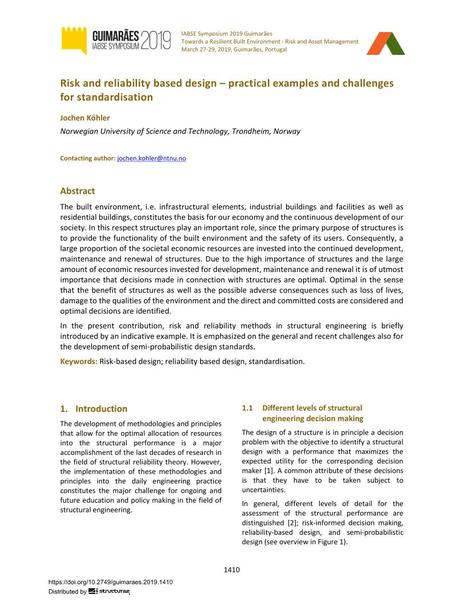Risk and reliability based design – practical examples and challenges for standardisation

|
|
|||||||||||
Bibliografische Angaben
| Autor(en): |
Jochen Köhler
(Norwegian University of Science and Technology, Trondheim, Norway)
|
||||
|---|---|---|---|---|---|
| Medium: | Tagungsbeitrag | ||||
| Sprache(n): | Englisch | ||||
| Tagung: | IABSE Symposium: Towards a Resilient Built Environment Risk and Asset Management, Guimarães, Portugal, 27-29 March 2019 | ||||
| Veröffentlicht in: | IABSE Symposium Guimarães 2019 | ||||
|
|||||
| Seite(n): | 1410-1417 | ||||
| Anzahl der Seiten (im PDF): | 8 | ||||
| DOI: | 10.2749/guimaraes.2019.1410 | ||||
| Abstrakt: |
The built environment, i.e. infrastructural elements, industrial buildings and facilities as well as residential buildings, constitutes the basis for our economy and the continuous development of our society. In this respect structures play an important role, since the primary purpose of structures is to provide the functionality of the built environment and the safety of its users. Consequently, a large proportion of the societal economic resources are invested into the continued development, maintenance and renewal of structures. Due to the high importance of structures and the large amount of economic resources invested for development, maintenance and renewal it is of utmost importance that decisions made in connection with structures are optimal. Optimal in the sense that the benefit of structures as well as the possible adverse consequences such as loss of lives, damage to the qualities of the environment and the direct and committed costs are considered and optimal decisions are identified. In the present contribution, risk and reliability methods in structural engineering is briefly introduced by an indicative example. It is emphasized on the general and recent challenges also for the development of semi-probabilistic design standards. |
||||
